Simulation of Temperature Distribution on the Face Skin in Case of Advanced Personalized Ventilation System
Abstract
1. Introduction
- remove/reduce the air pollution and generated heat (when not needed) locally;
- provide clean air, also heating and cooling, where, when, and as much as needed;
- make active control of the air distribution possible;
- involve each occupant in creating his/her own preferred microenvironment.
2. ALTAIR PV System
3. Methods
3.1. Geometry and Mesh
3.2. Physics Model
3.3. Radiation Model
4. Results
Results from the Cases
5. Conclusions
Author Contributions
Funding
Acknowledgments
Conflicts of Interest
Nomenclature
| AFT | average face skin temperature [°C] |
| ε | emission coefficient [-] |
| Isolar | solar radiation [W m−2] |
| TAF | fresh air temperature [°C] |
| TAV | ventilated air temperature [°C] |
| TSC | average cold surface temperature [°C] |
| TSW | average warm surface temperature [°C] |
| VAV | ventilated air volume flow [m3 h−1] |
| VAF | fresh air volume flow [m3 h−1] |
References
- Schär, C.; Vidale, P.L.; Lüthi, D.; Frei, C.; Häberli, C.; Liniger, M.A.; Appenzeller, C. The role of increasing temperature variability in European summer heatwaves. Nature 2004, 427, 332–336. [Google Scholar] [CrossRef]
- Kurnitski, J.; Saari, A.; Kalamees, T.; Vuolle, M.; Niemelä, J.; Tarke, T. Cost optimal and nearly zero (nZEB) energy performance calculations for residential buildings with REHVA definition for nZEB national implementation. Energy Build. 2011, 43, 3279–3288. [Google Scholar] [CrossRef]
- Kurnitski, J.; Allard, F.; Braham, D.; Goeders, G.; Heiselberg, P.; Jagemar, L.; Kosonen, R.; Lebrun, J.; Mazzarella, L.; Railio, J.; Seppänen, O.; Schmidt, M.; Virta, M. How to define nearly net zero energy buildings nZEB– REHVA proposal for uniformed national implementation of EPBD recast. Rehva J. 2011, 48, 6–11. [Google Scholar]
- Riffat, S.B.; Qiu, G. A review of state-of-the-art aerogel applications in buildings. Int. J. Low-Carbon Technol. 2013, 8, 1–6. [Google Scholar] [CrossRef]
- Umberto, B.; Lakatos, Á. Thermal Bridges of Metal Fasteners for Aerogel-enhanced Blankets. Energy Build. 2019, 185, 307–315. [Google Scholar]
- Lakatos, Á. Stability investigations of the thermal insulating performance of aerogel blanket. Energy Build. 2019, 185, 103–111. [Google Scholar] [CrossRef]
- Thalfeldt, M.; Pikas, E.; Kurnitski, J.; Voll, H. Facade design principles for nearly zero energy buildings in a cold climate. Energy Build. 2013, 67, 309–321. [Google Scholar] [CrossRef]
- Kalmár, F. Interrelation between glazing and summer operative temperatures in buildings. Int. Rev. Appl. Sci. Eng. 2016, 7, 51–60. [Google Scholar] [CrossRef]
- Kalmár, F. Summer operative temperatures in free running existing buildings with high glazed ratio of the facades. J. Build. Eng. 2016, 6, 236–242. [Google Scholar] [CrossRef]
- Zemitis, J.; Borodinecs, A.; Frolova, M. Measurements of moisture production caused by various sources. Energy Build. 2016, 127, 884–891. [Google Scholar] [CrossRef]
- Baranova, D.; Sovetnikov, D.; Semashkina, D.; Borodinecs, A. Correlation of energy efficiency and thermal comfort depending on the ventilation strategy. Procedia Eng. 2017, 205, 503–510. [Google Scholar] [CrossRef]
- Melikov, A.K. Advanced air distribution. ASHRAE J. 2011, 53, 73–78. [Google Scholar]
- Schiavon, S.; Melikov, A.K.; Sekhar, C. Energy analysis of the personalized ventilation system in hot and humid climates. Energy Build. 2010, 42, 699–707. [Google Scholar] [CrossRef]
- Pan, C.S.; Chiang, H.C.; Yen, M.C.; Wang, C.C. Thermal comfort and energy saving of a personalized PFCU air conditioning system. Energy Build. 2005, 37, 443–449. [Google Scholar] [CrossRef]
- Melikov, A.K. Personalized ventilation. Indoor Air 2004, 14, 157–167. [Google Scholar] [CrossRef] [PubMed]
- Zhang, H.; Huizenga, C.; Arens, E.; Yu, T. Modeling thermal comfort in stratified environments. In Proceedings of the Indoor Air, Beijing, China, 4–9 September 2005; pp. 133–137. [Google Scholar]
- Jones, L. Thermal touch. Scholarpedia 2009, 4, 7955. [Google Scholar] [CrossRef]
- Maula, H.; Hongisto, V.; Ostman, L.; Haapakangas, A.; Koskela, H.; Hyöna, J. The effect of slightly warm temperature on work performance and comfort in open-plan offices—A laboratory study. Indoor Air 2016, 26, 286–297. [Google Scholar] [CrossRef]
- Maula, H.; Hongisto, V.; Koskela, H.; Haapakangas, A. The effect of cooling jet on work performance and comfort in warm office environment. Build. Environ. 2016, 104, 13–20. [Google Scholar] [CrossRef]
- Griefahn, B.; Künemund, C.; Gehring, U. The significance of air velocity and turbulence intensity for responses to horizontal drafts in a constant air temperature of 23 °C. Int. J. Ind. Ergon. 2000, 26, 639–649. [Google Scholar] [CrossRef]
- Toftum, J.; Nielsen, R. Draught sensitivity is influenced by general thermal sensation. Int. J. Ind. Ergon. 1996, 18, 295–305. [Google Scholar] [CrossRef]
- Melikov, A.K.; Cermak, R.; Majer, M. Personalized ventilation: evaluation of different air terminal devices. Energy Build. 2002, 34, 829–836. [Google Scholar] [CrossRef]
- Sun, W.; Tham, K.W.; Zhou, W.; Gong, N. Thermal performance of a personalized ventilation air terminal device at two different turbulence intensities. Build. Environ. 2007, 42, 3974–3983. [Google Scholar] [CrossRef]
- Cermak, R.; Holsoe, J.; Mayer, E.; Melikov, A.K. PIV measurements at the breathing zone with personalized ventilation. In Proceedings of the Eight International Conference Air Distribution in Rooms, Roomvent, Copenhagen, Denmark, 8–11 September 2002; pp. 349–352. [Google Scholar]
- Gao, N.; Niu, J. CFD study on micro-environment around human body and personalized ventilation. Build. Environ. 2004, 39, 795–805. [Google Scholar] [CrossRef]
- Gao, N.; Niu, J. Modeling the performance of personalized ventilation under different conditions of room air and personalized air. Int. J. Heat. Vent. Air-Cond. Refrig. Res. 2005, 11, 587–602. [Google Scholar] [CrossRef]
- Kaczmarczyk, J.; Melikov, A.K.; Fanger, P.O. Human response to personalized ventilation and mixing ventilation. Indoor Air 2004, 14, 1–13. [Google Scholar] [CrossRef]
- Sekhar, S.C.; Gong, N.; Tham, K.W.; Cheong, K.W.; Melikov, A.K.; Wyon, D.P.; Fanger, P.O. Findings of personalized ventilation studies in a hot and humid climate. Int. J. Heat. Vent. Air-Cond. Refrig. Res. 2005, 114, 603–620. [Google Scholar] [CrossRef]
- Conceiçao, E.Z.E.; Manuela, M.; Lúcio, J.R.; Rosa, S.P.; Custódio, A.L.V.; Andrade, R.L.; Meira, M.J.P.A. Evaluation of comfort level in desks equipped with two personalized ventilation systems in slightly warm environments. Build. Environ. 2010, 45, 601–609. [Google Scholar] [CrossRef]
- Kalmár, F.; Kalmár, T. Alternative personalized ventilation. Energy Build. 2013, 65, 37–44. [Google Scholar] [CrossRef]
- Kalmár, F. Innovative method and equipment for personalized ventilation. Indoor Air 2015, 25, 297–306. [Google Scholar] [CrossRef] [PubMed]
- Kalmár, F. An indoor environment evaluation by gender and age using an advanced personalized ventilation system. Build. Serv. Eng. Res. Technol. 2017, 38, 505–521. [Google Scholar] [CrossRef]
- Kalmár, F. Impact of elevated air velocity on subjective thermal comfort sensation under asymmetric radiation and variable airflow direction. J. Build. Phys. 2018, 42, 173–193. [Google Scholar] [CrossRef]
- Kamár, F.; Kalmár, T. Study of human response in conditions of surface heating; asymmetric radiation and variable air jet direction. Energy Build. 2018, 179, 133–143. [Google Scholar] [CrossRef]
- Buzug, M.B.T.; Holz, D.; Kohl-Bareis, M.; Schmitz, G. Frontiers in Medical Imaging. In Proceedings of the VDE Kongress 2004, Berlin, Germany, 18–20 October 2004; pp. 37–42. [Google Scholar]
- MSZ EN ISO 6946:2017. Building Components and Building Elements. Thermal Resistance and Thermal Transmittance. Calculation Method (ISO 6946:2017); ISO: Geneva, Switzerland, 2017. [Google Scholar]
- Baehr, H.D.; Stephan, K. Heat and Mass Transfer; Springer: Berlin/Heidelberg, Germany, 2006. [Google Scholar]
- Frank, A.; Heidemann, W.; Spindler, K. Modeling of the surface-to-surface radiation exchange using a Monte Carlo method. J. Phys. Conf. Ser. 2016, 745, 032143. [Google Scholar] [CrossRef]
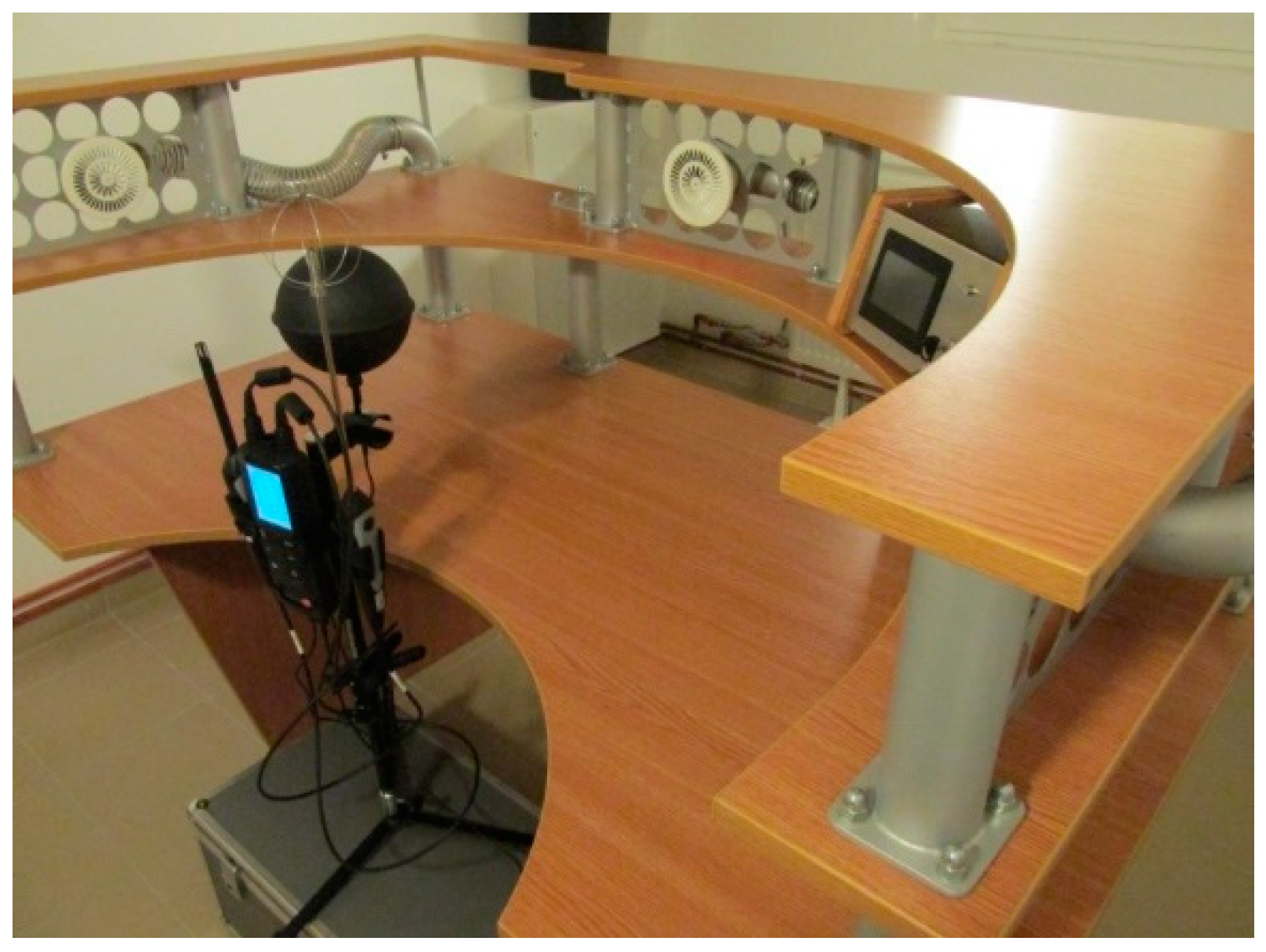

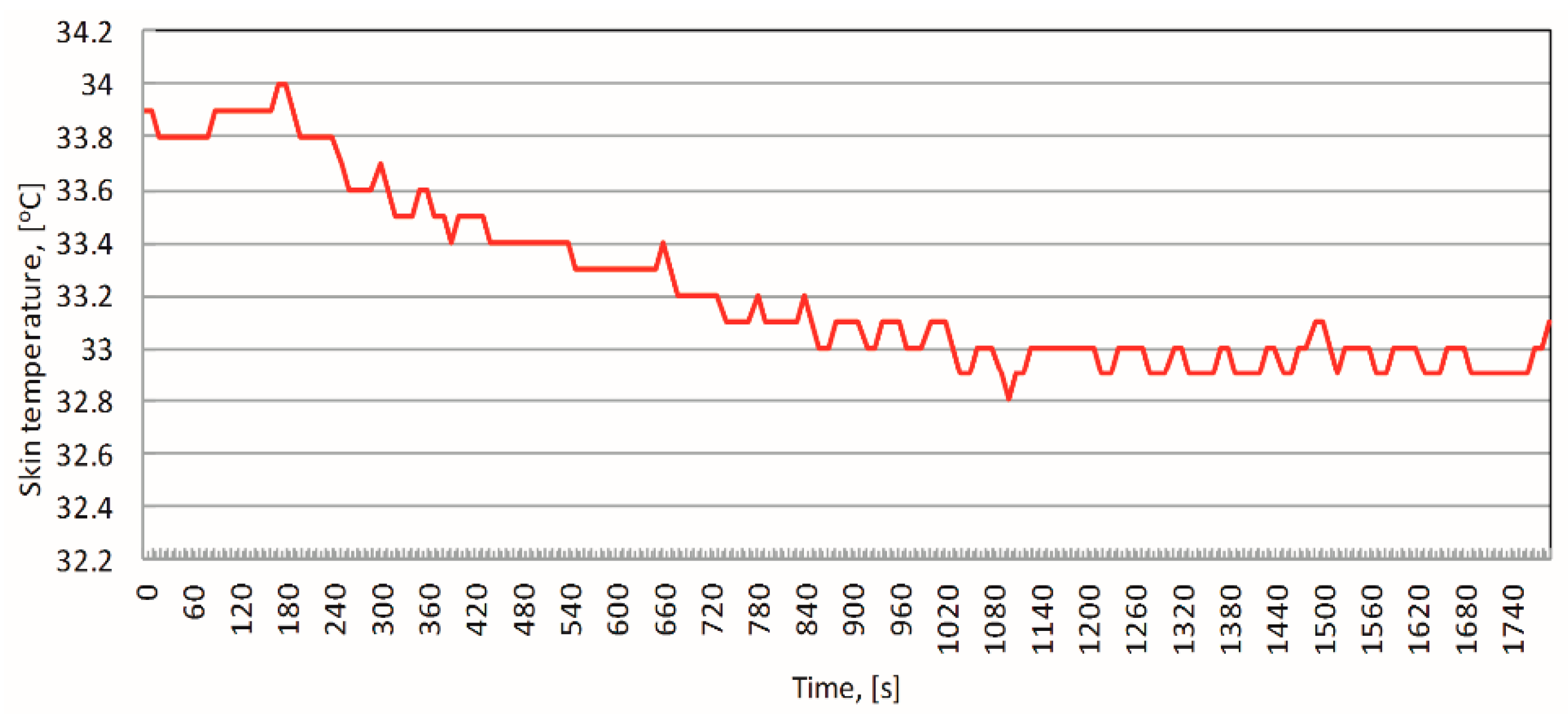
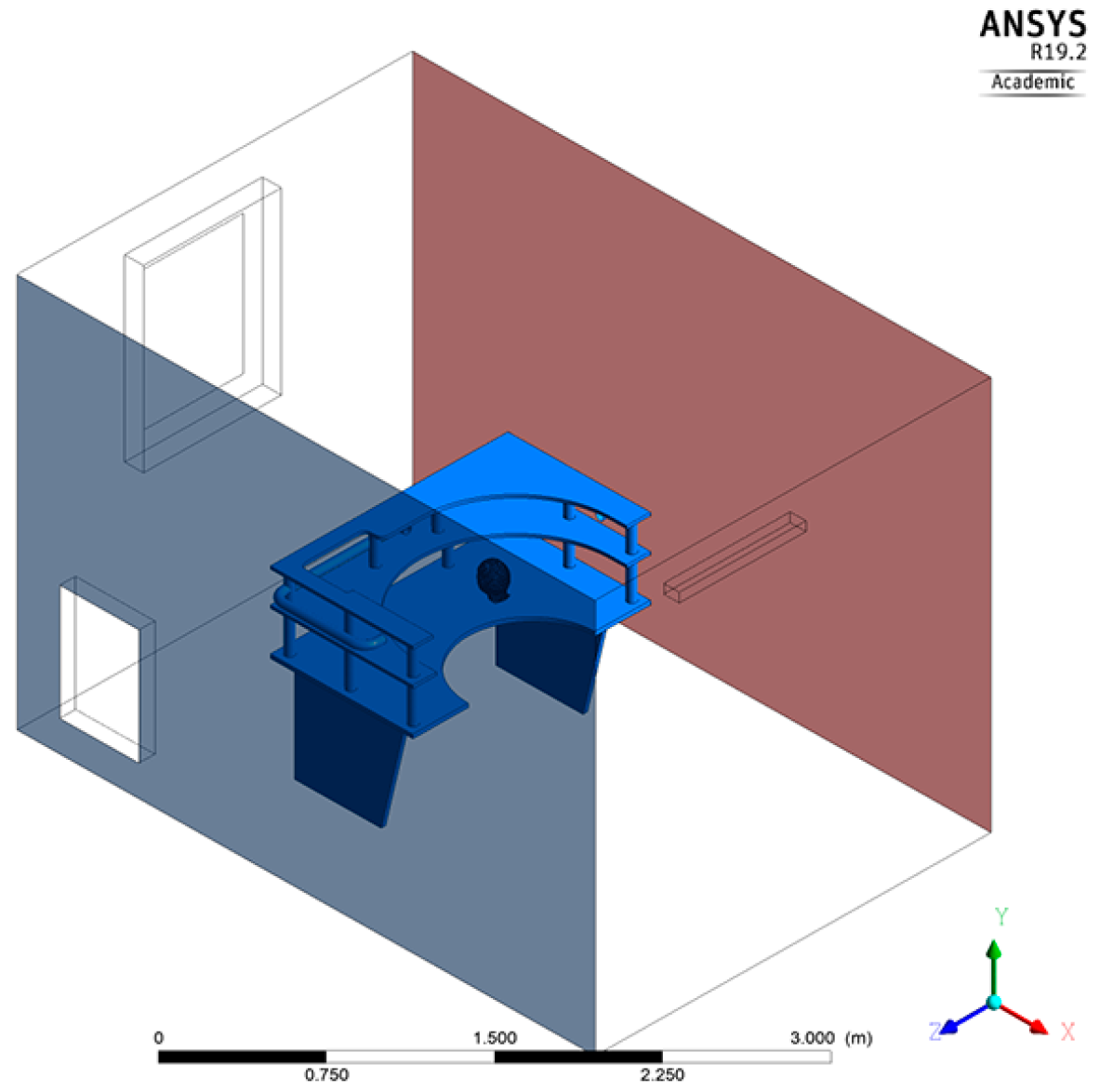
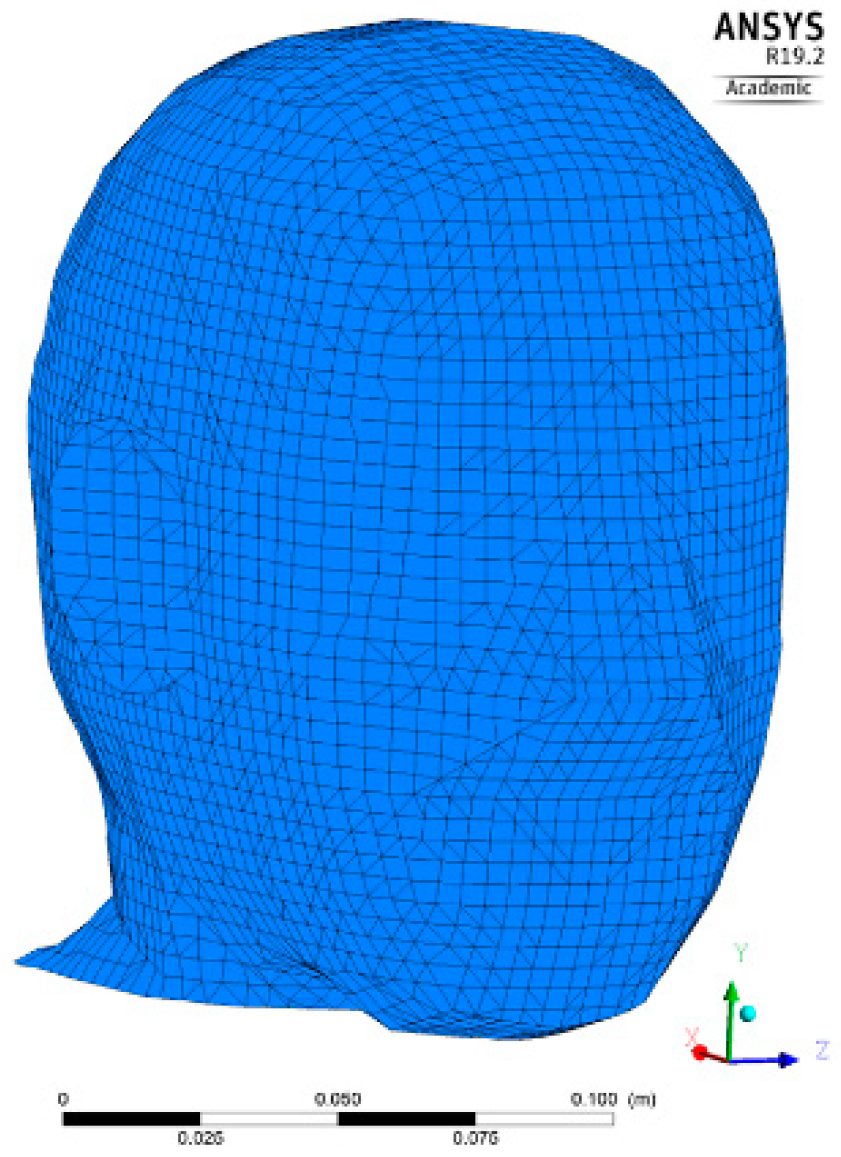


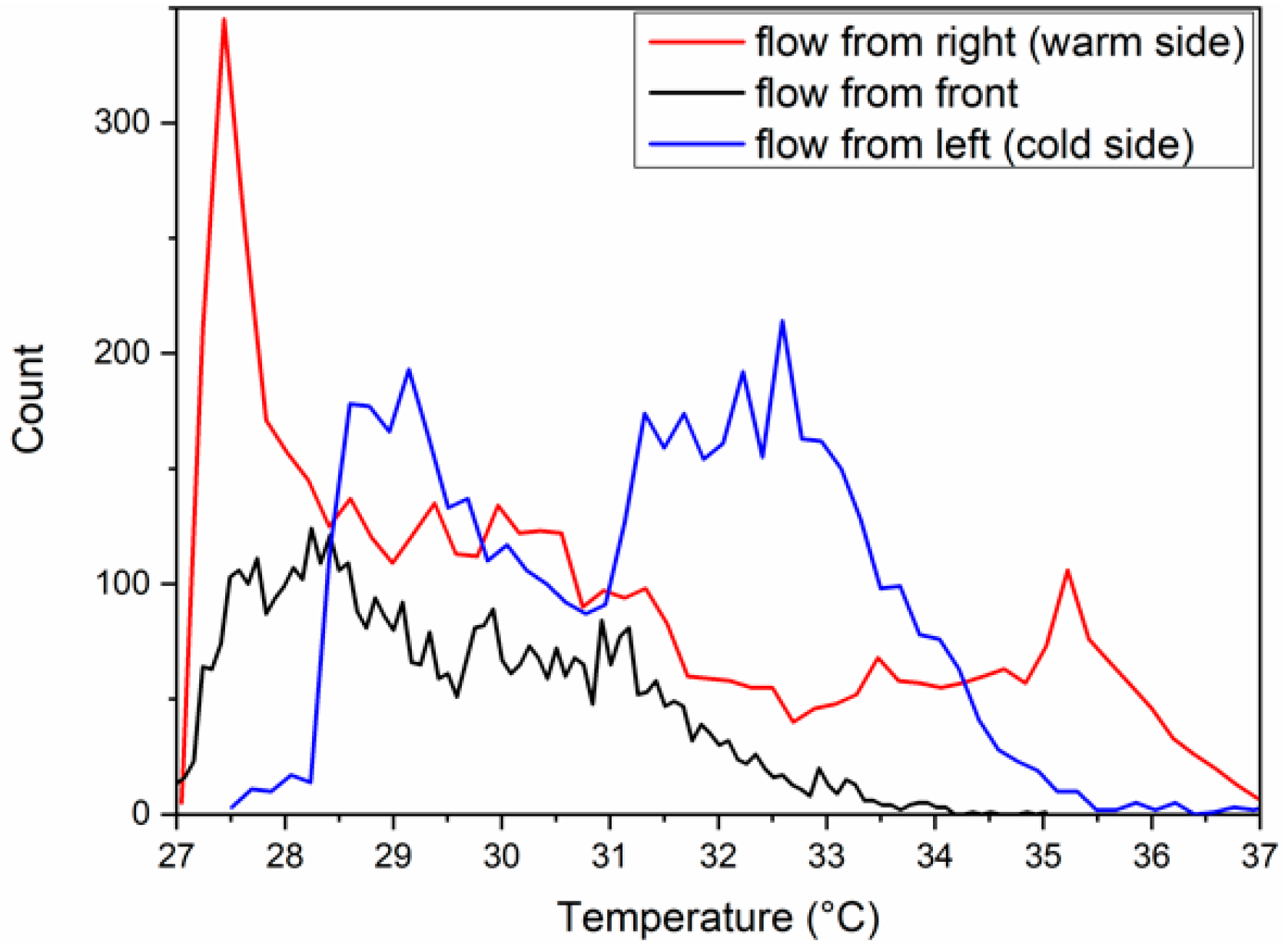


| Parameters | TSC | TSW | TAF | TAV | VAV |
|---|---|---|---|---|---|
| Units | [°C] | [°C] | [°C] | [°C] | [m3 h−1] |
| Validation case | 17.5 | 31.1 | 24 | 24 | 20 |
| Minimum value | 16 | 30 | 22 | 22 | 0 |
| Maximum value | 20 | 36 | 26 | 26 | 40 |
| Parameters | [K] | Error | [°C] | Error |
|---|---|---|---|---|
| left | 303.92 | 0.40% | 30.78 | 3.81% |
| front | 302.69 | 0.80% | 29.55 | 7.66% |
| right | 304.59 | 0.18% | 31.45 | 1.72% |
| validation [35] | 305.14 | - | 32 | - |
| average | 303.73 | 0.46% | 30.59 | 4.40% |
| TSC | TSW | TAV | TAF | Series 1 | Series 2 | Series 3 | Series 4 | Average |
|---|---|---|---|---|---|---|---|---|
| [°C] | [°C] | [°C] | [°C] | [°C] | [°C] | [°C] | [°C] | [°C] |
| 16 | 30 | 22 | 22 | 33.69 | 27.59 | 25.99 | 27.45 | 27.01 |
| 20 | 30 | 22 | 22 | 35.05 | 28.45 | 26.83 | 28.34 | 27.88 |
| 16 | 36 | 22 | 22 | 36.21 | 29.63 | 27.31 | 28.78 | 28.57 |
| 20 | 36 | 22 | 22 | 37.55 | 30.49 | 28.14 | 29.67 | 29.43 |
| 16 | 30 | 22 | 26 | - | 28.00 | 26.49 | 28.19 | 27.56 |
| 20 | 30 | 22 | 26 | 28.86 | 27.33 | 29.08 | 28.42 | |
| 16 | 36 | 22 | 26 | 30.04 | 27.80 | 29.52 | 29.12 | |
| 20 | 36 | 22 | 26 | 30.89 | 28.64 | 30.40 | 29.98 | |
| 16 | 30 | 26 | 22 | 28.95 | 27.91 | 28.89 | 28.58 | |
| 20 | 30 | 26 | 22 | 29.80 | 28.67 | 29.77 | 29.41 | |
| 16 | 36 | 26 | 22 | 30.96 | 29.11 | 30.21 | 30.09 | |
| 20 | 36 | 26 | 22 | 31.81 | 29.91 | 31.08 | 30.93 | |
| 16 | 30 | 26 | 26 | 34.39 | 29.34 | 28.35 | 29.61 | 29.10 |
| 20 | 30 | 26 | 26 | 35.75 | 30.20 | 29.11 | 30.49 | 29.93 |
| 16 | 36 | 26 | 26 | 36.90 | 31.36 | 29.57 | 30.93 | 30.62 |
| 20 | 36 | 26 | 26 | 38.24 | 32.21 | 30.39 | 31.80 | 31.47 |
© 2019 by the authors. Licensee MDPI, Basel, Switzerland. This article is an open access article distributed under the terms and conditions of the Creative Commons Attribution (CC BY) license (http://creativecommons.org/licenses/by/4.0/).
Share and Cite
Szodrai, F.; Kalmár, F. Simulation of Temperature Distribution on the Face Skin in Case of Advanced Personalized Ventilation System. Energies 2019, 12, 1185. https://doi.org/10.3390/en12071185
Szodrai F, Kalmár F. Simulation of Temperature Distribution on the Face Skin in Case of Advanced Personalized Ventilation System. Energies. 2019; 12(7):1185. https://doi.org/10.3390/en12071185
Chicago/Turabian StyleSzodrai, Ferenc, and Ferenc Kalmár. 2019. "Simulation of Temperature Distribution on the Face Skin in Case of Advanced Personalized Ventilation System" Energies 12, no. 7: 1185. https://doi.org/10.3390/en12071185
APA StyleSzodrai, F., & Kalmár, F. (2019). Simulation of Temperature Distribution on the Face Skin in Case of Advanced Personalized Ventilation System. Energies, 12(7), 1185. https://doi.org/10.3390/en12071185






